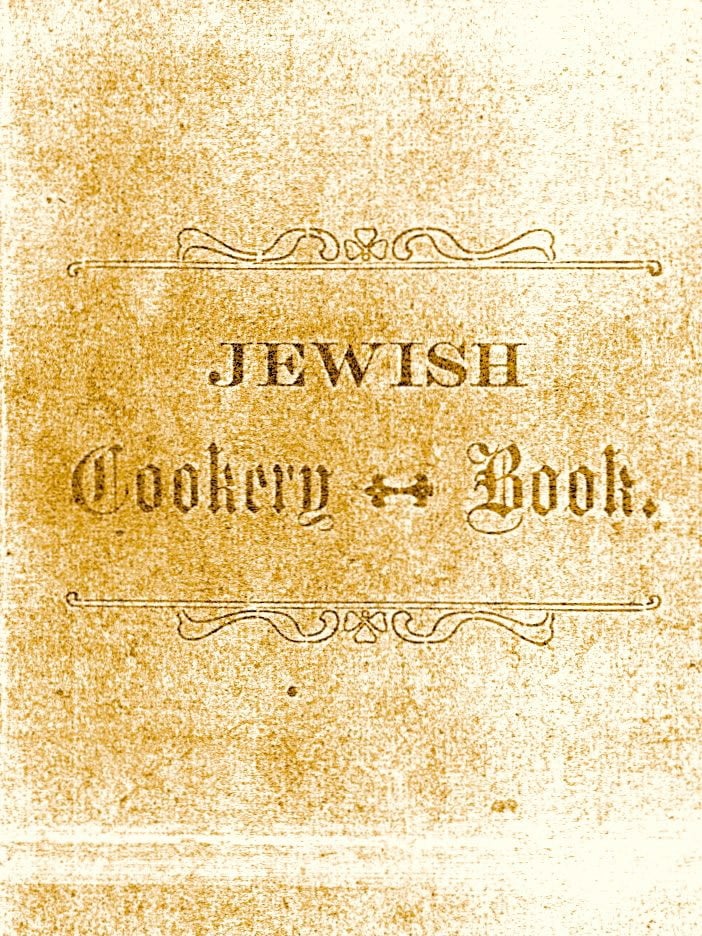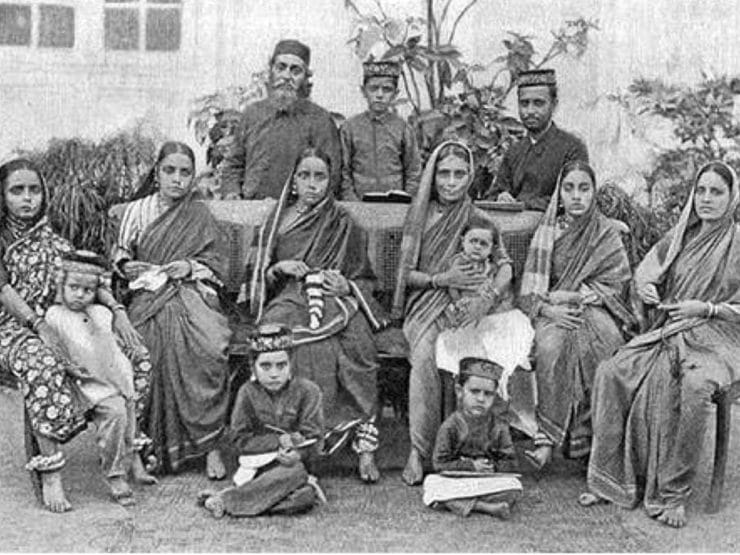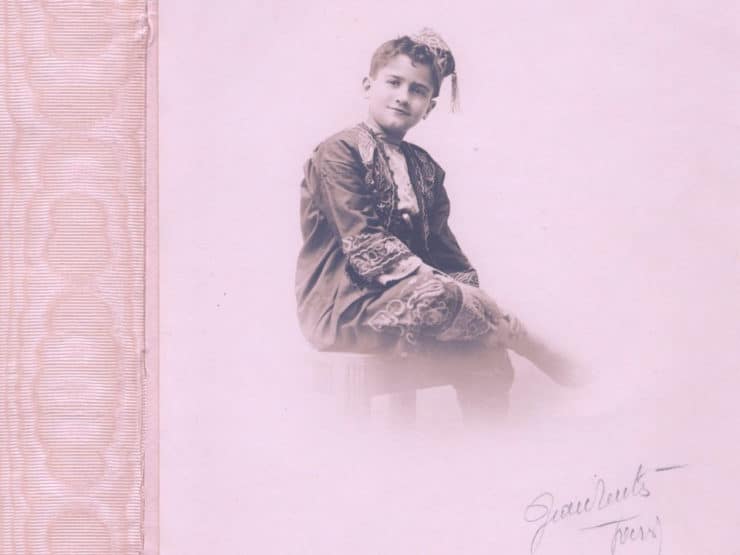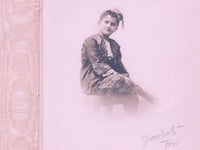
A few months ago, blog reader Barry Scott wrote me an intriguing email:
Dear Tori,
I thought that you might be interested in this cookbook. It was published in 1922 in Calcutta, India. My father-in-law, a Jew of Calcutta, gave a copy of this book to me. The Jews of Calcutta had a long and colorful history. They settled there well over two hundred years ago…
Barry scanned a copy of the book, entitled the Jewish Cookery Book, and sent it to me. It was published by Mrs. H. Brooke and printed by East Bengal Press, 52/9 Bowbazar Street, Calcutta. I have a pretty large collection of vintage cookbooks (both Jewish and non-Jewish), but this volume was totally new to me. It contains several kosher Jewish Indian recipes, including some I’ve never heard of before.
This seemed like the perfect opportunity to take a deeper look at Jewish Indian cuisine. I pored over the scanned pages of the cookbook, taking in all of the dishes, exotic spices, and ingredients. Some of the recipes were familiar to me, others completely new. I chose a dish that sounded tempting and went for it!
Before I started cooking, I did some research on the history of Indian Jewry. Rather than one mass migration, Jewish groups have settled in India at different times throughout the centuries. India’s Jews descend from four major groups—the Cochin, the Bene Israel, the Paradesi, and Baghdadi. The Bene Israel and the Cochin Jews claim to be descendants of the ten lost tribes of Israel.

Cochin Jews, circa 1900. Jewish Encyclopedia, 1901-1906
The Cochin Jews are the most ancient group of Jews in India. They claim roots in India from the time of King Solomon, though it can only be historically verified that they resided in India after 70 CE. After the Second Temple in Jerusalem was destroyed, a wave of settlers landed in the ancient port of Cranganore. They moved to nearby Cochin in the late fifteenth century after the Portuguese invaded, and were welcomed there by the maharajah. An area called Jew Town was established, where the Cochin Jews lived in harmony with their Hindu neighbors. They became involved in trading pepper, cinnamon, nutmeg, ginger, and other spices.
In the 16th century, Sephardic Jews were exiled from the Iberian Peninsula. A group of these Sephardim settled in Cochin. Known as Paradesi Jews, this group had lighter skin than the original Jewish settlers of Cochin (known as Malabari Jews). The customs of the Malabari were quite different from the Paradesi, and tension developed between the two populations. A division soon emerged; black Malabari Jews were often treated with disdain. They were barred from attending the white Paradesi Synagogue, and the Paradesi looked down upon the Malabari in business and trade dealings. Despite the issues between the Malabari and the Paradesi, the Cochin lived relatively peacefully in India for centuries.

Bene Israel Family at Bombay, circa 1900. Jewish Encyclopedia, 1901-1906
The Bene Israel Jews believe that their ancestors were oil pressers in the Galilee, who fled by sea to escape religious persecution in the 2nd century B.C.E. Legend says that seven Jewish couples survived a shipwreck on the Konkan Coast of India, on the shores of Kolaba; those seven couples are said to be the ancestors of modern day Bene Israel Jews. The shipwrecked Jews washed up near a village called Navgaon; all of their belongings were lost at sea. The survivors settled in Navgaon and started working in agriculture and oil pressing. Over the centuries, the descendants of the Bene Israel continued to carry on key Jewish traditions, including keeping kosher, circumcision, and observing Shabbat. The small group of Jews was “rediscovered” in the 18th century by traders from Baghdad, Iraq.
While the shipwreck story has at times been questioned over the years, the Bene Israel may, in fact, be right about their ancestry. According to a research study published in the early 90’s by Tudor Parfitt at London’s School of Oriental and African Studies, which gathered DNA from over 4,000 case studies, the Bene Israel are likely descendents of the Israelite Kohanim tribe.

Barry’s father-in-law, Ezra Joseph Gubbay, a Jew of Calcutta – 1930
More recently, a wave of Baghdadi Jews settled in India. Not all Baghdadi Jews are from Iraq; the Baghdadi name is also used to encompass immigrants from Iran, Yemen, and Afghanistan. Around 250 years ago, a wave of Jews emigrated from these countries to India, settling in Surat and later Bombay and Calcutta (now known as Kolkata). Baghdadi Jews established a trading network from Syria and Baghdad and Bombay to Calcutta, stretching all the way to Japan and Hong Kong. They quickly found success in trading, and the community thrived. Many Baghdadi Jews made their home in Calcutta, where Barry Scott’s father-in-law Ezra Joseph Gubbay lived—and where the Jewish Cookery Book was written. Ezra, like many Baghdadi Jews, was involved in various trading that included indigo, textiles, and precious stones.
Sadly, the population of Jews in India is now dwindling. After World War II, the rise of Indian nationalism made things tense for Jews in India, who were closely associated with Great Britain. The Jews began leaving in the 1940’s, emmigrating from India to Israel, the U.S. and England. A few elderly Jews stayed behind, but that population is slowly disappearing. In Calcutta, a once thriving community of 5,000 Jews is now on the verge of extinction.
The Jews may have left India, but their culinary traditions live on. Like other Jewish communities around the globe, Indian Jews have adapted the regional cuisine of their adopted country to make it kosher. The unique spices of the region are used freely in Indian Jewish recipes, as are regional kosher substitutes (like using coconut milk as a pareve alternative to milk or cream). Lamb (referred to in the cookbook as “mutton”) is used instead of beef as a red meat source; this is because the Hindus have a sacred respect for cows, and the Indian Jews generally respected this restriction. By exploring these recipes today and savoring these very special Indian flavors, we can imagine what it was like to live a Jewish life in India.
In my next blog, I’ll dig deeper into Ezra Joseph Gubbay’s family story. I’ll also share a recipe from the vintage Jewish Cookery Book from Calcutta. Stay tuned!
Update: I’ve posted the Gubbay family story and a recipe from this cookbook. Click here to view.



Dear Tori,
I hope this message finds you well. I recently came across your 2021 column about Jewish Calcutta on your blog, and I wanted to reach out and express my appreciation. Your thoughtful approach to Jewish culinary heritage and cultural storytelling resonates strongly with my own work.
I’m a descendant of that community. My father was from Calcutta. I am currently developing a book project that focuses on Baghdadi-Indian Jewish cuisine—an area that, like the community itself, has evolved over centuries through movement, adaptation, and creativity. This will be both a coffee-table style book and a practical, go-to recipe collection that explores the rich tapestry of flavors, techniques, and stories that define this extraordinary culinary tradition. My goal is to assemble a global network of contributors—people of different backgrounds and generations who share a connection to or fascination with this cuisine—so that we can capture a wide-ranging and authentic portrait of Baghdadi-Indian foodways today.
Your writing about Jewish Calcutta has really inspired me, although I have been at it for many years and now may be the right time to “come out of the closet”, so to speak.
https://www.jewishfoodsociety.org/stories/how-one-cook-in-switzerland-is-preserving-the-flavors
It’s encouraging to know there are others who understand the importance of preserving these lesser-known cultural histories through food. I’d love to connect with you, share more details about the project, and potentially explore ways in which we might collaborate or exchange ideas. If you have any interest—or suggestions about people to speak to, ingredients to highlight, or recipe sources—I’d be incredibly grateful.
Thank you for your time, your creativity, and your dedication to culinary storytelling. I’d be delighted to hear from you whenever it’s convenient.
Warmly,
Elli
Thank you for sharing your project, Elli!
I being an Indian origin is very excited to hear about this story of Jewish settlement in India. I am thankful for your effort to post such an ancient cookbook and recipes by Jewish Indians. Thank you! God bless you greatly!
Dear Toriavey
“. Sadly, the population of Jews in India is now dwindling. After World War II, the rise of Indian nationalism made things tense for Jews in India, who were closely associated with Great Britain. The Jews began leaving in the 1940’s, emmigrating from India to Israel, the U.S. and England. A few elderly Jews stayed behind, but that population is slowly disappearing. In Calcutta, a once thriving community of 5,000 Jews is now on the verge of extinction.
—
Indian nationalism did not make things tense for Jews! Complete identification with the British rulers and not with India/Indians made emigrating attractive for light skinned Jews.
Please note the only place where Jews have been welcomed, not just been accepted, has been India, due to Hindus. (Over all known history.) The early Jews received the best land as a gift to build their temple and it shared a wall with the Hindu temple. Jews have never faced discrimination there except from whiter Jews and the British who looked down on them (and built fortunes taking opium to China). During World War Two, British colonial rulers in India refused to let in European Jews escaping the war/Hitler. Nehru fought with the UK administration then in India to let them in, saying India has never refused anyone refuge.
The Jews of India are the one group that have never suffered forced conversion, marriages, rapes, or discrimination. They hardly knew about the Holocaust! In 1948, when Israel invited world Jewry home to Israel, Indian Jews refused saying they were already home. However Israel soon became a doorway to the west and Indian Jews started emigrating. Disillusioned, many asked to be repatriated to India. Later youngsters seeing more opportunities left India but never due to oppression.
Only the light skinned Jews and Baghdadis, who identified with colonial rulers and looked down on Indians/Indian Jews, left for Israel or the UK after ’47. (Indian Jews had to have separate synagogues and even burial grounds.)
Hi Tori: Chanced upon your site. I was born in Calcutta and from a Jewish family that came there in the 1880.
I now live in Singapore. My late mother was a great cook and taught many Calcutta Jewish recipes to my wife. If you could please e-mail me a scanned copy of the old Jewish Cookbook that would be more than amazing. Singapore – where the core of the Jewish community is also originally of Iraqi extraction that had very close ties with the Calcutta Jewish community- has a Jewish restaurant – Awafi – that recreates some of these classic dishes.
Looking forward to hearing from you.
Jacob.
I’m sorry, I’ve lost touch with the family so I don’t have access to the full copy. I’ve tried finding them without any luck. If they happen to see this post, they should reach out to me, as I’ve had many similar requests from other families.
I would also love a copy as I’m trying to learn more about the food my family would have eaten in Calcutta, so if the book turns up again, I would be interested!
Being a Bene Israeli (I am a Jew from Ahmedabad) I found it very interesting to learn about your family and happy to learn there is such an antique book passed on with traditional recipes.(these should not be forgotten). I loved the pictures you have posted. I am an avid collector of old photographs of Indian Jews.
Thanks for this.
Regards,
Ellana Shimshon
I am a filmmaker living in Calcutta. Presently I am doing a documentary on Baghdadi Jews of Calcutta. Your post is extremely relevant for my film. I’ll see if any of the Jews in Calcutta know Mr. Gubbay’s son in law Barry Scott. Mr. Gubbay’s photos are also very interesting.
Add me to the list of people very interested in a copy of the PDF of the cookbook. I wrote to you a few years ago about it but never received a response.
I found an interesting piece of information about the cookbook. According to these pages from the catalog of Hebrew and Samaritan manuscripts in the Sassoon Library in London (published 1932):
http://www.hebrewbooks.org/pagefeed/hebrewbooks_org_37056_427.pdf
http://www.hebrewbooks.org/pagefeed/hebrewbooks_org_37056_428.pdf
the author of the cookbook was not a woman but a man. Hayyeem Barukh b. Shalom b. Joseph Mingail is said to have had the book published in 1912 (?) through K. P. Mookerjee & Co., 20 Mangoe Lane, Calcutta.
Hi Janice, unfortunately I have lost touch with the family who has the original copy, I’ve tried all of the emails I have for them but they just get bounced back. Hopefully they will check in again with this post at some point and reach out to me! Meanwhile I am going to check on copyright information. If the book is out of copyright and no longer protected, then I will try to make it available on my website.
Love your site! Were you ever given permission to scan the cookbook?
Hello,
My name is Shinjini and i am a research scholar working on cultures of food in colonial Bengal In Centre for Studies in Social Sciences,Calcutta. This cookbook is of immense importance for my work and i would request you to share the cookbook with me. they are rare treasures and needs preserving. it would be of immense help if you could let me know the name and publication details of the book.
Shinjini, the name and publication details appear at the beginning of this post.
Hello-
You mentioned in a previous comment you would ask the Scott family if this could be shared and get back to the person; I am unable, however, to locate this book. If the book is public domain-and I’m not sure it is-would they mind if they could sell PDFs of the book? I believe there is some demand for this book, although limited…I would buy a copy if it were available!
Friends of ours are currently spending a few months in Kolkata and offering blog posts about their experiences there. Here’s one about meeting someone in Kolkata, Jael, who is one of the last Jews there. Jael is collecting documents about Jews in Kolkata, including cookbooks, I assume, so I sent our friend a link to this blog post to pass along to Jael. The URL for this blog post, with photos of a lovely Kolkata synagogue, is as follows: http://alanteller.wordpress.com/2013/12/11/post-11-the-jews-of-kolkata/comment-page-1/#comment-34
Hi
My name is Ilanit and I live in Israel. 2 month ago I’ve opened a blog of Cochin Jewish Cuisine, which include recipes that have been passed down over the years. My aim is to preserve this tremendous food that is slowly disappear from the world as this small glorious community is been assimilated and extinct. You are most welcome to visit my blog and enjoy these wonderful tastes and flavors.
http://chipappam.blogspot.co.il/
Hello Ilanit, and many thanks for your post about your blog. Although my family are all Ashkenazai, I am very interested in learning about Cochin Jewish Cuisine. So I eagerly clicked through to your blog. But I don’t speak or read Hebrew, so I needed the translation. However, the translation has problems, e.g., two of the ingredients for kallappam chykiz are “1 medium land development” and a “crocus.” Other recipes have other problems. Is it possible that you know someone who could translate to English?
Also, I live in a university town in the U.S. where a graduate student, who occasionally attends our synagogue services, is the child of a family from Cochin. I know they would greatly appreciate your blog, but I suspect they too don’t read or speak Hebrew.
I do, though, appreciate knowing about your blog. Thanks.
Hi,
“Spice & Kosher – Exotic Cuisine of the Cochin Jews”, by Dr. Essie Sassoon (of Ashkelon, Israel), Bala Menon and Kenny Salem (both of Toronto) has just been published and is now available worldwide.
There are about 200 fabulous Cochin Jewish recipes and also a lot of historical information in the book. Recipes were collected from many members of the Cochin Jewish community in Israel, India, United States and Canada.
Regards
Bala Menon